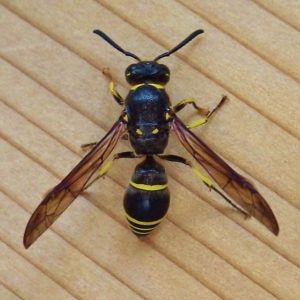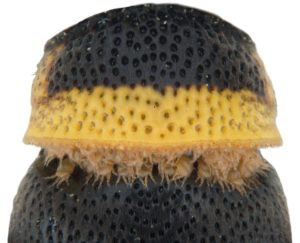A wasp love story
Girl wasp meets boy wasp. Girl wasp gets it on with boy wasp. Boy wasp gives girl wasp a STD with a difference…
STDs are common among the animals and we can be fairly certain that any animal that engages in sex is troubled by at least one pathogen that uses sexual intercourse to get about. In vertebrates these STDs are nearly always bacteria or viruses, but the agents of insect STDs are often worryingly larger and more mobile.
A fascinating example of this is this wasp story, which actually concerns a type of mason wasp (Ancistrocerus antilope). This graceful little insect is found throughout much of the Palaearctic and Nearctic, even in our biologically impoverished corner of Europe.

The male of this wasp species has a dirty little secret – it’s riddled with a STD, in the form of clamouring mites clinging to its abdomen just waiting for their moment. This moment is when these wasps have sex. Mating in these insects is a rather fleeting affair, but it’s enough time for roughly half of the male’s mites to scuttle aboard the female. When the wasps part company the mites make straight for the genital opening of the female wasp and block it up, which prevents her from having sex again, thus securing the male’s paternity.

@tombosanyeh)
This is extraordinary, yet it is only the beginning of the tale, because the mites have to get onto the next generation of wasps, so they stay on the female while she builds a nest. This nest is usually inside a hollow plant stem and eventually consists of a number of cells with mud partitions, each of which is stocked with small, paralysed caterpillars – food for the wasp’s offspring – and a single wasp egg.

During the construction of the nest, the mites (immature at this point), take their leave of the female and initially feed on the haemolymph of the poor, paralysed caterpillars. The wasp larva, once hatched, makes short work of the provisions, grows quickly and pupates.
Here, there is another astonishing twist in the tale because the fate of the mites in each cell of the nest depends on whether the wasp larva is male or female. Once a female wasp larva has finished scoffing the paralysed caterpillars it seeks out and consumes every single mite in its cell before it pupates. In contrast, the male wasp larva leaves the mites in its cell alone and pupates. The now adult mites shift their attentions to the male wasp pupa and suck its haemolymph. These giants STDs now mate and have their own offspring that also feed on the male wasp pupa.
When the adult wasps finally emerge, the new batch of immature mites in the cells of the male wasps climb aboard their new hosts to continue this extraordinary cycle. As the female wasps leave the nest they may occasionally pick up a couple of mites from the empty male cells as they head to the exit, but on the whole they are wasp free.
Since Cowan investigated this extraordinary symbiosis more than 30 years ago (see below) no one has really look into it, but there are loads of questions still to explore. At face value, it would appear that the males, in transmitting the mites, are reducing the fitness of their offspring, but we have to remember the mind-bending haplodiploid sex determination of wasps. In these animals, fertilised eggs develop into females and unfertilised eggs end up as males. Therefore, only the female offspring have any of their father’s genes. In contrast, the male offspring derive all of their genes from their mother.
The mites are getting a lot out of this relationship. They get dispersal, food (the haemolymph of the caterpillars and male wasp pupa) and a safe place to develop (the wasp’s nest). What do the wasps get? The mites act as a post-coital chastity belt for the male wasps – guaranteeing paternity, but that’s about all that is known. The male wasps must pay a price in terms of fitness because the mites feed on their haemolymph. Perhaps a male wasp with a heavy burden of mites is more ravishing to female wasps? Perhaps the mites feed on parasitoid eggs and larvae inside the nest? Perhaps the female wasp larvae gain something from consuming all of the mites in their cell? There’s still so much to understand and if you’re a biologist just starting out this would be a fascinating story to understand.
This is just one example of the almost incomprehensible variety of interactions that are taking place on our planet every single day. This is why it would takes thousands of years to understand life on Earth and why everyone with an interest in the natural world should be excited at just how much there is to discover.
If this floats your boat there’s more here:
Cowan DP (1984). Life history and male Dimorphism in the Mite Kennethiella trisetosa (Acarina : Winterschmidtiidae) and its symbiotic relationship with the wasp Ancistrocerus antilope (Hymenoptera: Eumenidae). Annals of the Entomological Society of America 77, 725–732.
Knell RJ and Webberly KM (2004). Sexually transmitted diseases of insects: distribution, evolution, ecology and host behaviour. Biol Rev 79(3): 557-81.
Krombein KV (1967). Trap-nesting Wasps and Bees: Life Histories, Nests, and Associates. Smithsonian Press, Washington, D.C., 20560.

Leave a Reply